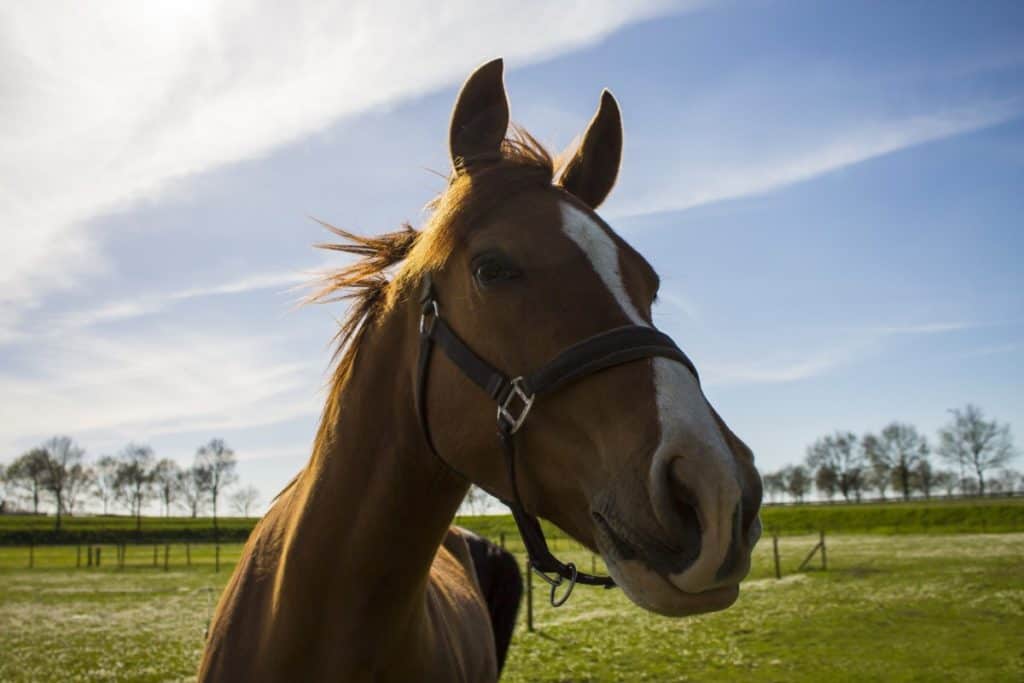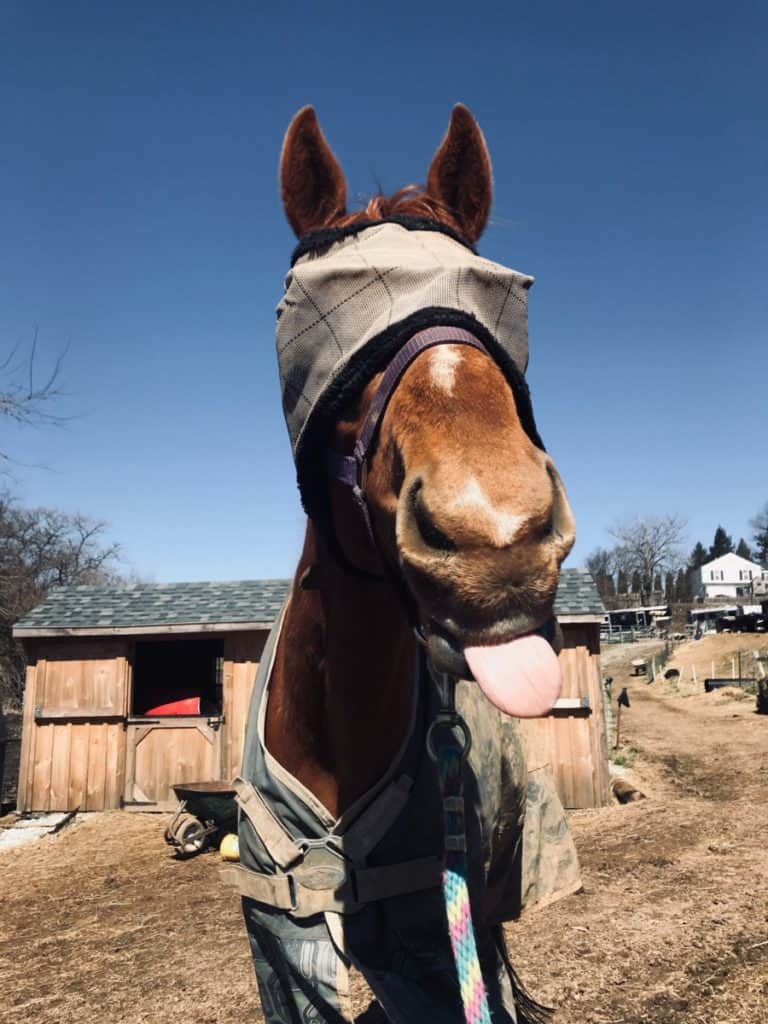
When summer approaches, and we all get excited about spending more time outdoors, somehow my mother’s voice always creeps into my mind telling me ‘make sure to apply sunscreen before you go outside’. And since my horse is pretty much MY baby it made me wonder, shouldn’t I be protecting her from the sun?
Do Horses Get Sunburned? Horses can get sunburned if they are exposed to the sun over extended periods of time. Light and pale-colored horses are at the highest risk and the areas most frequently affected are the nose and around the eyes. Sunburn initially manifests as skin lesions but can develop into painful blisters in more severe cases.

Just like us, horses can get burned by the sun if exposed to it for too long, and non-pigmented horses such as Paints and Appaloosas are particularly vulnerable. Luckily, there are easy measures we can put into place to stop this from happening while still allowing our horses to soak up that highly beneficial vitamin D.
How Do Horses Get Sunburned?
The most common reason why horses burn in the sun is that they are left outside in direct sunlight for too long without and shaded areas available to cool off in. And even when shaded areas exist, if grass or hay is more readily available in the sun-exposed spots, horses may still choose to spend most of their time there. When feeding hay outside in the summer, leave it in shaded areas to the extent possible. Just like with humans, light-skinned horses are more likely to burn as they have less pigment in their skin and therefore burn faster.
Another very different reason why some horses get sunburned is because they suffer from a condition called photosensitivity, which makes their skin far more susceptible to UV-rays than other horses. There are three types of photosensitivity; primary, secondary and a genetic version (source). Primary photosensitivity occurs when photosensitizers are present in the circulation of the horse’s blood and are usually ingested via certain plants, dyes, and medicaments such as John’s Wort, Ragwort, Buckwheat, Perennial Ryegrass, sulfa and tetracycline antibiotics.
Secondary photosensitivity occurs due to liver damage, which results in toxin buildup in the bloodstream. Such liver damage can be caused by the ingestion of Alslike Clover, Red Clover, Fiddleneck and Common Helitrope. Finally, although very rare in horses, photosensitivity can also be genetic.
Photosensitivity is different from regular sunburn as it often affects all areas of the body, not only the lighter pigmented areas and it is difficult to know if a horse suffers from the condition before it experiences burns. Identify burns, especially on darker horses, can also be difficult, as the lesions may not be very apparent and could delay a very important diagnosis. If you suspect your horse suffers from photosensitivity, contact a veterinarian as soon as possible.
The first signs of sunburn usually occur on the face and manifests in the form of skin lesions and a pink/red hue in the affected areas, similarly to humans. If the exposure is more intense or the horse suffers from photosensitivity, blisters (sometimes oozing) and scaling of the skin is common, and the horse often expresses its discomfort by becoming ‘head shy’ or oppose saddling due to the pain it is experiencing.
How do I Prevent my Horse from Getting Sunburned?
The most effective way to prevent sunburn is to adapt your turn-out and riding schedule for late afternoon and early mornings to avoid exposing your horse to the peak hours when the sun is at its strongest. Make sure there are enough shaded areas in the fields or paddocks, especially if leaving your horse outside all day. If you ride during the hottest part of the day, try to opt for shaded areas as much as possible.
Depending on how sensitive your horse is to the sun and how long it will be exposed to the sun rays, it can be a good idea to apply sunscreen and/or use protective gear. UV-resistant head and muzzle masks are a good option to protect the sensitive eye and muzzle areas as well as light rugs or fly sheets to protect the horse’s body. We love how this one from Amazon basically makes the horse look like a superhero while being effective and durable.

Can I Use Human Sunscreen on my Horse? What Sunscreen is Safe for Horses?
Physical sunscreens or sunblock that creates a protective layer on the horse’s skin are a great option to protect it from sunburn. These products are usually zinc oxide-based and are best suited to the smoother areas of the horse’s skin such as the muzzle. Although horse-specific SPFs exist, it is perfectly fine to use human sunscreen for your horse as long as it is PABA-free (para-aminobenzoic acid), just make sure it is high enough (SPF 15 or higher is recommended by the FDA) and a waterproof is highly recommended. Avoid applying any chemical sunscreen around a horse’s eyes.
How to Apply Sunscreen on a Horse
Just like children, horses may not be very happy about sunscreen application and it can turn into a bit of a battle. Keep the tube or tub in a temperate space, try to be quick and non-ceremonial about the application and remember that the cream does not need to be rubbed in. In fact, leaving a visible layer will help you easily see if the cream has rubbed off and you need to reapply.
If you are using a new product, always do a spot test first and leave it for 24 hours to make sure your horse does not have any adverse reactions. After that, the recommendation is to apply 30 minutes before sun exposure and re-apply every 2 hours. For many, that schedule is simply not realistic, which is where UV-resistant clothing for your horse comes in as a good alternative.
How to Treat Sunburn on Horses
If a horse has already been sunburned it should immediately be taken out of the sun and its wounds inspected. For light burns, gently clean the skin, apply a cooling product such as aloe vera or diaper rash ointment and cover the area with sunscreen to protect it from any additional exposure.
For more severe burns and where blisters have appeared, the horse should be seen by a veterinarian both to treat the affected areas, but also to investigate the underlying problem (which could be photosensitivity).
All horses that have been sunburned should be encouraged to drink water as being hydrated will aid in the healing process. Depending on the severity of the burn, the healing process can take several weeks, and it is important to allow enough time for your horse to recover before attempting to tack him up again as rubbing the affected areas can make things a lot worse and feel very uncomfortable for the horse.
Related Questions
What can you put on a horse’s sunburnt nose? If a horse has a light sunburn the area should be gently cleansed and then a soothing product such as aloe vera or diaper rash ointment can be applied. It is advised to protect the horse from the sun until the burn has healed, but if the area will be exposed to sunlight again, be sure to also cover it in a physical sunblock.
Do true black horses fade in the sun? For most black horses it is normal that their coat will fade some in color during the summer where the coloring can go towards a slight red/brown hue. The black color will come back after a while when the horse is no longer exposed to the sun. Some horses are however non-fading black and their coats do not fade in the sun.
This article is accurate and true to the best of the author’s knowledge. It is not meant to substitute diagnosis, prognosis, treatment or any type of medical advice for humans or horses. Animals exhibiting signs and symptoms of distress should be seen by a veterinarian immediately.


